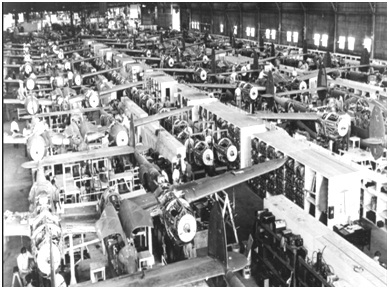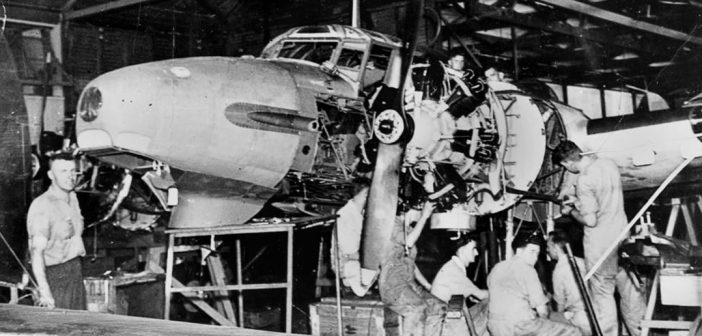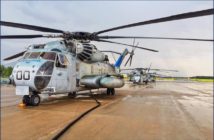 On September 14, 2017, the Grampaw Pettibone Squadron was pleased to have as its guest speaker Mr. Dana T. Parker, author of Building Victory, Aircraft Manufacturing in the Los Angeles Area in World War II. In his presentation, Mr. Parker described the evolution of aircraft manufacturing in Southern California during WWII. At that time, LA aircraft manufacturers were engaged in the greatest effort in history to increase aircraft production from a handful to thousands.
On September 14, 2017, the Grampaw Pettibone Squadron was pleased to have as its guest speaker Mr. Dana T. Parker, author of Building Victory, Aircraft Manufacturing in the Los Angeles Area in World War II. In his presentation, Mr. Parker described the evolution of aircraft manufacturing in Southern California during WWII. At that time, LA aircraft manufacturers were engaged in the greatest effort in history to increase aircraft production from a handful to thousands.
In less than five years, aircraft manufacturing in the US climbed from 41st place to first place among American industries. This achievement centered in the LA areawhere companies such as Douglas Aircraft Co. in Santa Monica, Hughes in Culver City, Lockheed in Burbank, North American Aviation near Inglewood, Northrop in Hawthorne, Vultee in Downey, as well as countless subcontractors who made a major contribution. In 1939, total US military aircraft production was less than 3000 aircraft. From 1940-45, the US produced nearly 300,000 planes total. This met the goal set by President Roosevelt who requested 50,000 planes per year.
 Mr. Parker stated in his presentation that the war was won as much by machine shops as machine guns. Machine tooling and parts manufacturing broke all production records during the war years. More aircraft were manufactured in one year than had been manufactured in all of the pre-war years since the Wright brothers invented the airplane. In spite of the challenge laid out to meet war footing production with sometimes inexperienced personnel, productivity increased, doubled and doubled again between 1941 and 1944. It was double that of German counterparts and four times that of Japanese workers. By 1943, it exceeded the combined total production of both the UK and USSR. As a result of the war footing, as much as 40% of the workforce throughout many factories were women. Some draft age men with significant manufacturing skills were recruited to this effort and were prevented from enlisting or being drafted.
Mr. Parker stated in his presentation that the war was won as much by machine shops as machine guns. Machine tooling and parts manufacturing broke all production records during the war years. More aircraft were manufactured in one year than had been manufactured in all of the pre-war years since the Wright brothers invented the airplane. In spite of the challenge laid out to meet war footing production with sometimes inexperienced personnel, productivity increased, doubled and doubled again between 1941 and 1944. It was double that of German counterparts and four times that of Japanese workers. By 1943, it exceeded the combined total production of both the UK and USSR. As a result of the war footing, as much as 40% of the workforce throughout many factories were women. Some draft age men with significant manufacturing skills were recruited to this effort and were prevented from enlisting or being drafted.
In order to meet the war demands, large assembly-line operations were required. Whereas pre-war builders would move from plane to plane in a batch process, in war time, the plane would travel to the builder. The approach would have equipment setup in one direction to receive raw material and move the aircraft along the line to deliver a finished product. Some operations would have multiple lines of production to build the fuselage as two separate parts and then assemble both sides as production progressed. Manufacturing was a 24 hour, 7 day a week, sometimes 365 day per year process. To protect plants in Southern California many were camouflaged to hide the operations from possible airborne attacks.
Many plants moved from manual operation to automated production without a break. It put a significant burden on personnel and equipment usage to maintain production requirements. Vultee Aircraft was the first company with an automated aircraft assembly line and the first to hire women on the assembly line. When interior factory space was not available, aircraft were finished outside taking advantage of fair LA weather. When subcontractors and parts manufacturers could not keep up with production, such as rubber for tires, wood was used as a temporary replacement. Other innovations in manufacturing included tubular steel and molten zinc.
 Among the more noted achievements within the aircraft industry was the Lockheed Aircraft Corporation. With no previous military production experience, Lockheed produced the P-38 Lightning, the only aircraft to be produced throughout the entire war years of US involvement. Mr. Parker provided photos of various aircraft manufacturing in the LA area and the evolution of the locations over the years. Most of the land used by the aircraft manufacturers has since been modernized and some continue to serve a roll in the aerospace industry while others were turned into shopping malls and apartment buildings. A few buildings have been recognized for their historical significance.
Among the more noted achievements within the aircraft industry was the Lockheed Aircraft Corporation. With no previous military production experience, Lockheed produced the P-38 Lightning, the only aircraft to be produced throughout the entire war years of US involvement. Mr. Parker provided photos of various aircraft manufacturing in the LA area and the evolution of the locations over the years. Most of the land used by the aircraft manufacturers has since been modernized and some continue to serve a roll in the aerospace industry while others were turned into shopping malls and apartment buildings. A few buildings have been recognized for their historical significance.
Mr. Parker concluded his presentation by discussing aircraft drone manufacturing during the WWII period. Southern California produced radio controlled models and full size planes to be used as drones for training gunnery teams as well a attacking enemy installations. A well-known company of the period, the Radioplane Company located in the Los Angeles area had an employee photographed by an army photographer as a publicity photo. The employee later went on to a modeling and acting career. Her name was Marilyn Monroe.




